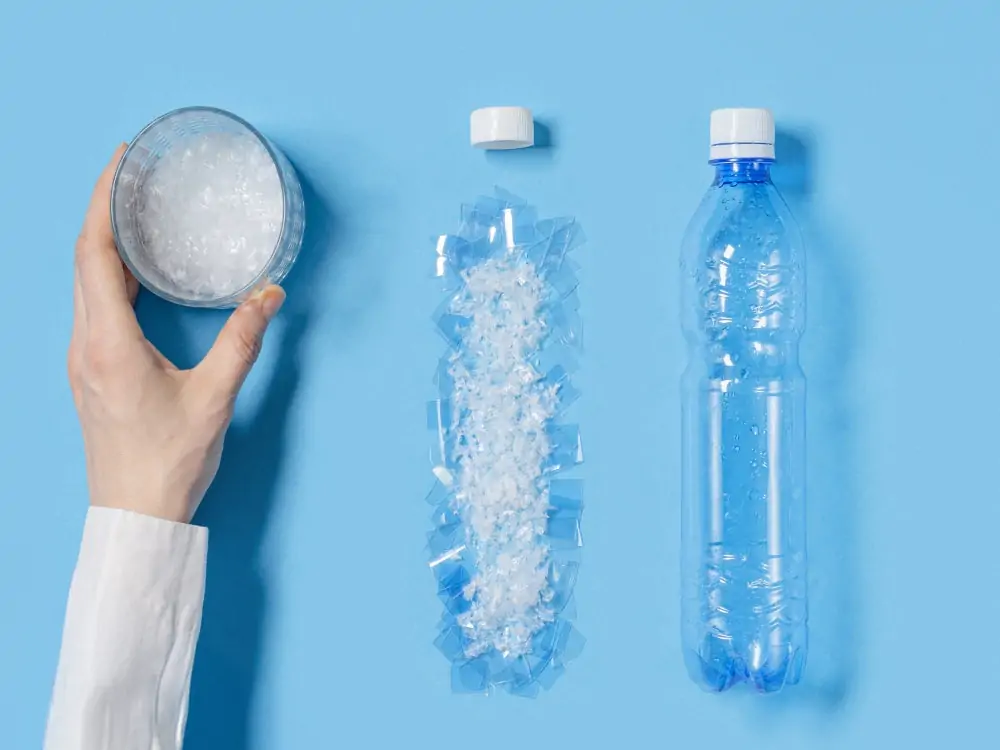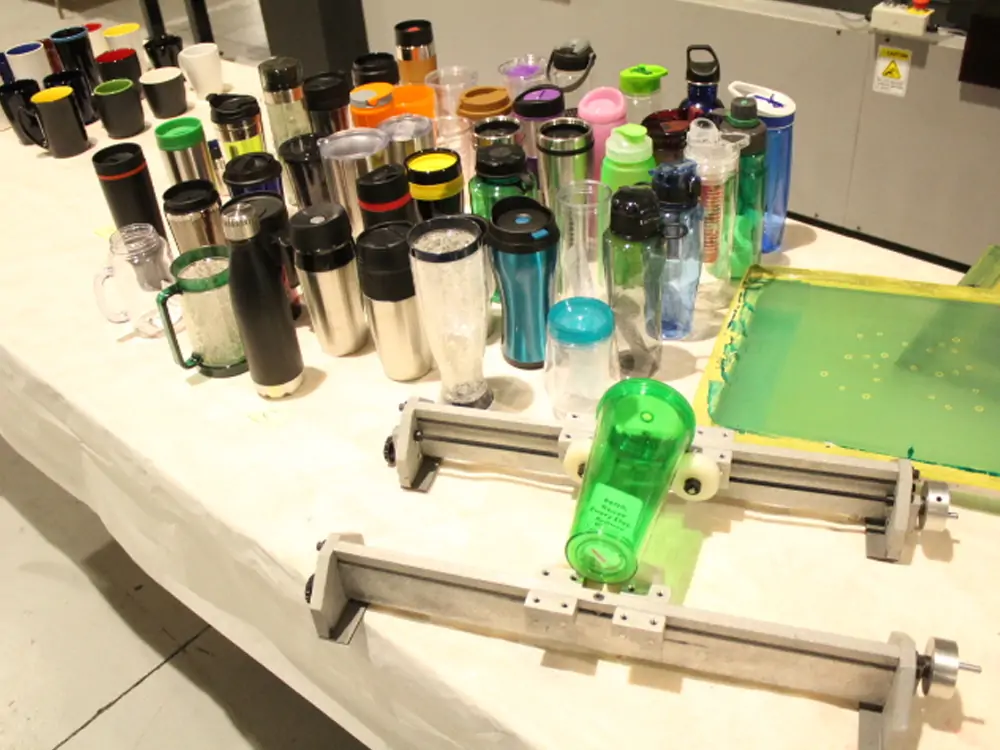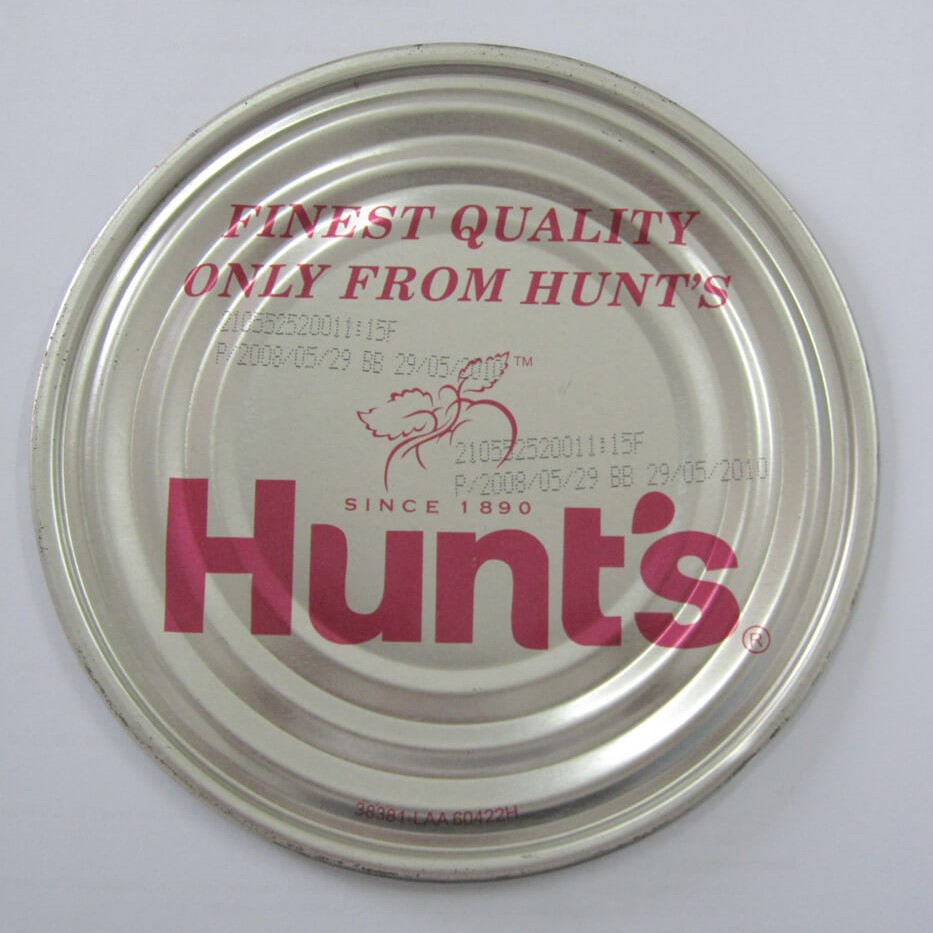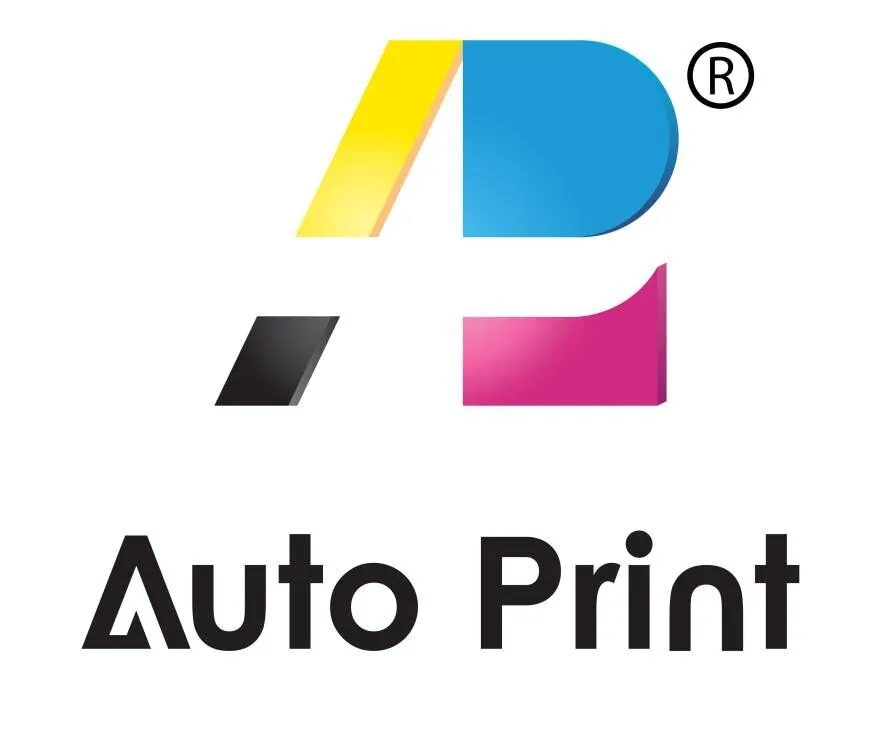Did you know that more than 60% of the round packaging in the cosmetics and drink industries uses screen printing? That’s quite a substantial amount, and it’s growing rapidly. If you’re in the packaging or product decorating business, you definitely can’t ignore cylindrical screen printing. It works quickly and is very reliable, especially when it comes to printing on bottles, tubes, jars, and other containers.
However, in this case, the saying ‘you get what you pay for’ fits. The quality of the surface you print on affects the quality of the print. If the surface is not suitable or doesn’t dry properly, it will result in a product of poor quality. This causes problems such as wasted ink, the need for reprinting, and unhappy clients.
Since the primary goal of this blog is to help you identify the best materials for cylindrical screen printing, we’ll discuss PE, PP, and PET plastics in more detail, followed by glass, metals, ceramics, and even wood and bamboo.
You’ll learn what needs to be done for each one, the best inks to use, what to avoid, and what problems to look out for. This will help make sure your prints not only stick, but also stay sharp.

Understanding Cylindrical Screen Printing
What Is Cylindrical Screen Printing?
Cylindrical screen printing is a method of printing on round or curved surfaces, such as bottles, jars, and tubes. It differs from flatbed printing because it operates through movement. The product rotates while the screen remains stationary.
The screen only touches the product at the points where they meet. Ink is pushed through the screen using a squeegee. Since the screen moves along with the product, full 360-degree coverage is possible. This method is quick, effective, and ideal for printing large quantities of containers.
Why Material Matters
Every part of the printing process is affected by the material you choose. The surface energy of the material matters too; if it’s too low, the ink won’t stick. Surface tension that is too high or too low can cause blurry or shifted prints.
Other factors, such as the surface’s porosity and its ability to retain its shape, also matter. That’s why pre-treatment is important. Surface energy can be improved through treatments such as flame or corona treatment. These treatments help the ink stick better.
Without them, weak prints and smudges are more likely to occur. It’s essential to select the appropriate material and pair it with the suitable treatment and ink.
Cylindrical screen printing is useful because it works on many types of round objects. It applies ink directly to curved surfaces. To achieve good results, you need to thoroughly understand the material. Each surface needs different types of ink, pre-treatment, and care. To get good, sticking, and long-lasting results, you need to pick the right materials.
If you try to print on a surface with low surface energy, the ink won’t stick well. Good preparation stops printing problems. Let’s look at the materials most commonly used in this type of printing. This includes glass, metals, and plastics. We’ll also look at wood, bamboo, and ceramics. Each material has its advantages and disadvantages.
Knowing these will improve your print quality. This will help you understand which materials work well for you. It clearly explains the steps to follow for good printing. The goal is to get high-quality prints. People who work in screen printing need this knowledge.

Plastics
In cylindrical screen printing, plastics are used everywhere. They are cheap and easy to work with. However, they can be tricky due to their varying chemical compositions. Many plastics require treatment before they can be printed on. Plastics must be matched with the right ink for optimal performance. If not, you may get poor sticking or smearing. It’s very important to understand the different types of plastic.
Polyethylene (PE)
Found in many everyday items, polyethylene is a useful plastic. It’s popular because it’s flexible and cheap. PE has low surface energy, which means the ink won’t stick easily without the help of a primer. However, that also means it has fewer sticking problems when treated properly.
This requires some form of surface treatment. Surface treatments, such as flame or corona treatment, enhance the adhesioning of ink. Without treatment, proper sticking of inks may not be achieved. The best inks for PE are either UV-drying or solvent-based inks.
Polypropylene (PP)
Polypropylene, or PP, is a lightweight material that is resistant to chemicals. It is widely used in the medical packaging field. And it is also used in a large number of food packaging containers. It has very good blocking features. Ink sticking has problems with PP.
It often needs flame treatment to get the desired surface. This treatment helps with PP. Surface energy is increased. Solvent inks, UV inks, and two-part strong glue-like inks are all suitable for use on PP.
PET (Polyethylene Terephthalate)
PET or Polyethylene Terephthalate is very clear. It is often seen in water bottles. It has good hardness and is tough against many chemicals. Many drink containers are made out of PET. With PET, many ink systems do not need pre-treatment.
This is because its surface energy is higher. PET also works well with UV inks. PET is resistant to most inks,, and UV inks are very fast and long-lasting.
| Material | Surface Energy (dyn/cm) | Pre-treatment Required | Compatible Ink Types | Application Example |
|---|---|---|---|---|
| PE | 31–33 | Flame/Corona | Solvent, UV | Cosmetic Bottles |
| PP | 29–31 | Flame/Corona | Solvent, UV, Two-Part Epoxy | Medical Containers |
| PET | 42–46 | Optional | UV | Water Bottles |
This table provides key information about common plastics. These help in deciding the right method. Surface energy and pre-treatment are needed. Ensuring that the plastic and ink adhere well is also very important.

Glass
Glass has a high-end look and is very clear. Many products prefer this material. The issue with glass is the printing part. It has a hard and smooth surface that requires special treatment.
Properties and Challenges
Glass’s surface is hard and smooth, which makes it hard for inks to stay. This makes it important to use strong chemical inks. Additionally, glass surfaces must be clean to ensure proper ink adhesion. Oils and fingerprints can significantly affect the adhesion of ink. Sticking is needed for screen printing. These help the inks stick. Also, the screen mesh with thick inks must be set up well.
Suitable Applications
Glass is widely used in the manufacture of perfume and wine bottles. It is also common for lab tools. These need to have strong and good-looking prints on glass. This can be done by using ceramic and enamel inks. For these inks, high heating is a must. This is needed to stick the ink to the glass. In return, this makes strong and scratch-proof prints. You get long-lasting decoration.

Metals
Metals offer a long-term durability and a modern aesthetic. Often, round metal objects go through screen printing. They are often made with aluminum and stainless steel. Each metal needs certain steps afterward.
Ensuring the metal surface is treated before printing helps ensure proper ink adhesion. Additionally, the ink must adhere well to the metal to prevent chipping or flaking. The heating temperature must not be too low.
Aluminum
Aluminum’s light weight, rust resistance, and good reaction to cleaning and coating make it great for use in bottles, tubes, and flasks. Aluminum works well with epoxy or baked enamel inks, which are strong, and medium-level heating works well for them.
Stainless Steel
Stainless steel is strong and rust-proof. It is used in medical or laboratory containers, as well as in other reusable containers. It is great for tough jobs. Extra care is needed when printing on stainless steel. The surface needs to be roughened or cleaned to help the ink stick, and stainless steel needs higher temperatures. Epoxy or UV-drying inks are best.
| Type of Metal | Surface Preparation Required | Suggested Inks | Temperature Resistance |
|---|---|---|---|
| Aluminum | Clean, Coat | Epoxy, Enamel | Medium |
| Stainless Steel | Roughen, Clean | Epoxy, UV-drying | High |
A comparison of aluminum and stainless steel surface preparation is presented in this table, along with other key points related to metal printing. It highlights the importance of surface preparation in achieving printing success.
Ceramics
Ceramics are smooth and easy to break, and are used in mugs, vases, as well as medicine bottles. Like other surfaces, the prints need to be made using special methods. The ink used in ceramics is often glass-like compounds. These prints are baked at high heat.
The ink is joined with the ceramics during the baking process. This gives a long-lasting and dishwasher-safe finish. It is also important to use a specific mesh count and squeegee pressure.
Wood and Bamboo
Wood and bamboo are increasingly being used in eco-friendly packaging and promotional items. These materials give a unique and natural look.
However, their surfaces need to be specially prepared before printing. You must sand and seal the surface first. This makes the prepped area smoother, resulting in better evenness. Ink soaking increases or decreases depending on how open the surface is, and this needs to match the thickness of the ink. Printing on the material requires a slow speed for accuracy.
during the baking process. This gives a long-lasting and dishwasher-safe finish. It is also important to use a specific mesh count and squeegee pressure.
Ink Systems for Different Materials
Just as important as picking the material is picking the right ink system. Inks are formulated based on the surfaces they are used on, so they must be matched according to how they dry and adhere. Picking the right material will help the ink stick better and last longer.
If you use the wrong ink, the print may get damaged or smudged. This occurs when the ink fails to adhere to the surface. Each material has its features. In this case, surface energy and heat resistance are important.
Common Ink Types
In cylindrical screen printing, there are many ink types. Each one has its features. UV-curable inks are unique because they dry immediately when exposed to UV light. Solvent-based inks dry through evaporation. Epoxy and two-part inks adhere well and last a long time. Ceramic inks are unique because they must be baked at high temperatures, making the print long-lasting and adhering to the surface.
| Type of Ink | How It Dries | How Well It Sticks | Works On | Notes |
|---|---|---|---|---|
| UV-Curable | UV Light | Medium to High | PET, PP, PE, Glass | Dries fast, low smell |
| Solvent Based | Air/Oven | High | PE, PP, Metals | Strong smell, can catch fire |
| Epoxy | Heat | Very High | Glass, Metal | Stays strong even in tough use |
| Ceramic | Kiln | Permanent | Ceramics, Glass | Used in medicine and dishware printing |
This table serves as a suggested starting point for various ink types. It focuses on how they dry and how well they stick. It helps you select the right ink more quickly.
Surface Preparation Techniques
Preparing the surface is crucial in every print job, as it helps the ink adhere more effectively. Better surfaces mean better sticking. In surface treatment, the goal is to make a firm surface for the ink. Doing this step in a closed space helps avoid common printing problems.
Why It’s Critical
To work well with inks, the surface tension must be lower than the surface energy. If the energy is too low, the ink will form drops. It won’t spread. Cleaning is necessary to remove dust, oil, and other debris. Dirt stops the ink from bonding with the surface. If they don’t stick well, gaps form. Clean surfaces give strong and clear prints.
Methods Used
A wide range of ways can be used to prepare surfaces for priming. Flame treatment, for example, specially burns plastic surfaces, increasing their energy. Corona discharge also raises the energy for films and plastics.
Plasma treatment is accurate and offers gentle cleaning of the surface, ensuring that delicate materials remain untouched. Wood and metals can be sanded and cleaned. These methods give the materials an ink-friendly surface.
Challenges and Mitigation Tips
No matter how well you plan, problems will come up. The world of round prints is highly specialized and comes with numerous challenges. Being aware of common problems will help you plan and prepare for simple fixes.
Common Print Issues by Material
Spreading ink is a common problem that can be seen on wooden surfaces. The uneven soaking of the surface is often the reason for this flaw. Peeling is common with untreated plastics. Poor alignment is often seen on uneven surfaces.
Drying cracks can also be seen on ceramics and glass. Many of these problems come from using low-quality materials and doing steps in the wrong order. Once the cause is found, fixes are often simple and can be done ahead of time. Your methods must ensure that the steps you follow yield the desired prints and are reliable.
Solutions
Selecting the right surface treatment for each material ensures that the surface energy is optimal. For even ink spreading, adjust the squeegee hardness and angle. It is important to match the ink type with the drying method and surface. This ensures the ink is properly dried and adheres well. Always conduct thorough testing before large-scale runs. This helps in finding and fixing problems early. Strong, good-quality prints are made.
Conclusion
Printing on round items is very useful, but only when you know the material you are printing on. Every surface comes with its own needs and challenges that you need to adjust for. To avoid costly repairs, it is essential to select the correct ink, preparation method, and drying system. That will make sure the prints last long.
A printer’s time spent learning about materials pays off in better products. The surface should be chosen carefully. Always test to ensure the quality remains good. That knowledge matters whether you are printing 10,000 shampoo bottles or 500 steel flasks. Learn and follow these basics for printing success.
Contact Us today to get the high-quality materials printing machine.
